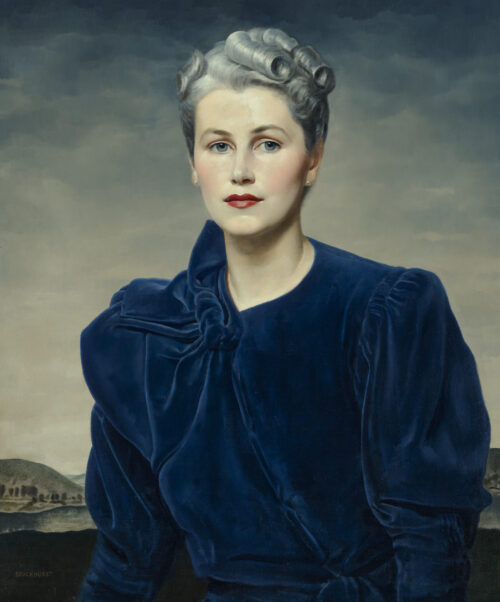
Gerald Leslie Brockhurst
“..in what follows I argue that a great deal will be attained if we can begin to raise (or even to see) the question of Greek Bronze as a question. “
Babette Babich (Greek Bronze: Holding a Mirror to Life)
“Of course, the fairy-tale world, especially as a magical one, no longer belongs to the present. How can it mirror our wish projections against a background that has long since disappeared? Or, to put it a better way: How can the fairy tale mirror our wish-projections other than in a totally obsolete way? Real kings no longer even exist. The atavistic and simultaneously feudal-transcendental world from which the fairy tale stems and to which it seems to be tied has most certainly vanished. However, the mirror of the fairy tale has not become opaque, and the manner of wish-fulfillment that peers forth from it is not entirely without a home.”
Ernst Bloch (The Fairy Tale Moves on Its Own in Time)
“Evidently a different nature opens itself to the camera than opens itself to the naked eye […] The camera intervenes with the resources of its lowerings and liftings, its interruptions and isolations, its extensions and accelerations, its enlargements and reductions. The camera introduces us to unconscious optics as does psychoanalysis to unconscious impulses.”
Walter Benjamin (Art in the Age of Mechanical Reproduction)
“True thoughts are those alone which do not understand themselves.”
Theodor Adorno (Minima Moralia)
“There is no light in the Disneylands spread across the globe, only darkness and banality.”
Jack Zipes (Grimm Legacies)
I wanted to look at notions of Greek Statuary, that Babette Babich raises, as well as how some of these ideas relate to theatre. But also how they relate to the psychoanalytic implications for culture occurring today, which is tied to a loss of reading overall. And by extension to the loss of meaning. And by another degree, how this loss of meaning relates to the political states of crisis globally. The turning of everything into ideology. And how technology intercedes in all of this. But to do this it is best to begin with some observations about Greek culture, an Oral culture, and the dawn of writing, and of reading.
“Those Greeks who did not quite simply reject writing, as Pythagoras and Socrates did, tended to prefer the activity of writing to the “passivity” of the reader (who is passive in that he is “subjected” to the writing). As soon as we recognize the instrumental nature that one who reads aloud assumes in relation to the writer, we are struck by the analogy between the categories of written communication and those of another Greek social practice, recently analyzed by Michel Foucault: I refer to pederasty. The relationship between the *erastes* ‘lover’, who is active and dominant, and the *eromenos* ‘beloved’, who is passive and dominated, raises questions similar to those inherent in the relationship that binds the writer to the reader and tends to make reading the devalued underside of writing. “
Jesper Svenbro (Phrasikleia)
I do not want to spend too much time on this, although I might in a later post, but there is a point I’d like to argue in the following paragraph.
“One consequence of the Greeks’ reading aloud is that the reader is thus presented as an eromenos. But there are others. The writer necessarily depends on the voice of the reader. At the moment of reading, the reader relinquishes his voice to what is written and to the absent writer. That means that his voice is not his own as he reads.”
Jesper Svenbro (Ibid)
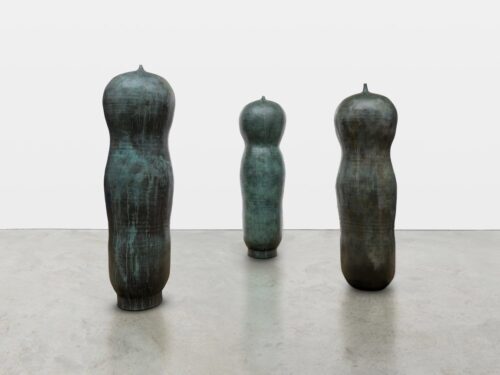
Toshiko Takaezu
Perhaps in some sense — though I sort of doubt it — the writer is dependent on the voice of the reader. In Greece of this era reading was primarily done aloud. But even then the *reader* has agency in this, and the mimetic process of internal re-narrating (whether the reading is aloud or silent) is part of the subject’s own self interrogation. Unless it is being posited that looking at something also surrenders autonomy to that which is viewed. Nobody would suggest this as its nonsensical, but here were are dealing with language, and with alphabets and as soon as language enters the discussion things get significantly more complicated. Still, the submissive (a bottom, in this homoerotic context) reader is not defined by his ‘bottomness’. And I would posit one has to look at the entire evolution of theatre and religion here. As I have noted countless times theatre precedes religion. At the point where writing becomes normalized, the reciting of something written by another becomes a significant shift. The memorization is also tied into the obsessive/compulsive repetition theory of Freud (and Lacan and et al). Rehearsal, where this memorizing is tested, and perfected (sort of) is a part of the giving away of the self with which the actor is engaged.
Larry Shiner posits what he calls a fateful division in how society views ‘art’ taking place in the 18th century. Essentially, there was a formal separation between ‘refined pleasure’ and ‘ordinary pleasure’. The invention of the ‘fine arts’. And earlier than this, really, came an opposition between artisan and artist. By the end of the 18th century there was a clear sense that objects deserving of ‘refined pleasure’ were also to be appreciated by a kind of rapt attention (as M.H. Abrams put it). This is more or less accurate enough, though I think we see in 20th century art historians the beginning of a closeted (sic) hostility to the spiritual element in ‘art’. But well before the 18th century there was a sense in which the lower classes did not appreciate the serious genius of a Shakespeare (hence they got some comic relief in parts).
But I do not want to digress too far, here. I will return to what is, I think, wrong with much of how art history is written. Shiner’s schematic history is not wrong if you are teaching 10th graders, but it is certainly a simplistic reading of all this. Art and culture are inextricably tied to consciousness and our complex socio-political lives, and our personal allegorical narratives of living. Art is reproducing suffering. In fact most of life is a reproducing of suffering, a never ending tension within our psyche that must defend against trauma but also manufactures trauma. As Adorno noted, every artwork is an uncommitted crime.

Geraldo de Barros (1950)
“Setting aside the all-too-modern preoccupation with desire and the body (where it is likely that a great deal of our attention to the erotic in antiquity is tied to our own Western conventions as can be seen from a comparative review of contemporary literature with the literature, say, of Wilamowitz’s day: for if the details differ, the obsession is the same), the Nietzschean argument suggested above goes beyond Deborah Tarn Steiner’s account in her Images in Mind to say that the Greek would have first found himself politically (or civically) in agonistic and active terms by ‘looking in’ (and, so I here contend, back to himself) in the statue. This same effectively reflective ‘looking in’ corresponds to the playing aspect of the shining surface of bronze.”
Babette Babich (Ibid)
Looking in at the surface, metaphorically suggests looking ‘deeper’ into the truth of the statue, which as Babich notes, is a way of looking at ourselves. And I am reminded that this week I was thinking about how I miss ‘doing’ theatre. And yet while all but literally blackballed from the stage I continue to write about it and think about it. And turning 74 later this week made me aware that this question, this idea of ‘my’ reader, begins to loom ever larger. I think the answer is that to understand the truth of theatre is a way to understand oneself. At least to some degree. But to realize that particular alchemy of self analysis I still need an ‘audience’. If literally nobody read these writings, on this blog, what would that mean? If I was the last man on earth, what would it all mean? I make this digression because in a sense these are questions that my reading of Babich raises.
Bronze sculptures, as created by the Greeks, suggest something uncannily lifelike. Or rather, not lifelike exactly. And it is this ‘not exactly’ part wherein resides the meaningful insights.
“Consciousness, we recall, is always consciousness of something, and it is worth reflecting on the question of what it is that takes us by surprise in such incidental mirroring encounters. For thus we can catch sight of and so almost ‘meet’ the aspect of ourselves as we might be bringing-forth our own appearance, our ‘look’ as we are in the world, as we show ourselves forth and are given to another’s gaze. The incidental sight of ourselves can ‘catch us up,’ bringing us as we-appear-in-the-world to ourselves and that also means, though exactly this is not evident, as we might be seen by others. “
Babette Babich (Ibid)
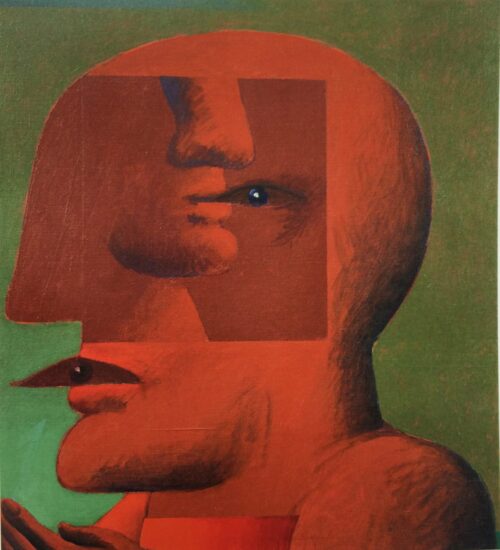
Horst Antes
“An everyday phenomenological reflection on reflection reminds us that when it comes to our own angles of appearance, we are aware of the keen relevance of points of view, especially as such perspectives are always already cascading to angles unseen and in sight, even at first glance.”
Babette Babich (Ibid)
I am reminded of a number of things here. First is Lacan, and his mirror phase. Also how health spas always put in ‘thinning’ mirrors that make everyone look trimmer than they actually are. What do we ‘really’ see in reflection? That for the Greeks the Bronze statue carried with it something like a quality of ‘lifelike’ makes sense. But like in theatre, the audience is not ‘fooled’ that they are watching a scene from ‘real’ life. There is a ceremonial understanding behind the artworks. Of course at the same time the theatre audience also does believe in what is on stage. Many playwrights over the years have written impossible stage directions — even if highly naturalistic as playwrights; Ibsen for one in Brand ( a favorite of mine) or Artaud (Jet of Blood), or DeGhelderode, or Shakespeare even. Contemporary playwrights are often strategically trying to find that pure theatrical space that Jan Kott describes so beautifully in Shakespeare Our Contemporary when he writes of the Mad Tom scene. Bernhard, or Handke, or Muller are all in search of this returning gaze Babich posits. The bronze, polished in ways probably lost in the mists of time (to use a cliche), was not mistaken as a living human, but was something more than human. And here I am reminded of Kleist’s essay Marionette Theatre.
https://15orient.com/files/kleist-on-the-marionette-theatre.pdf
For Kleist, the marionette is superior to the dancer because the dancer possess self consciousness.
“Taoism holds the same view as Kleist on the great importance of spontaneity. For the Taoist, one must always reflect things like a mirror, and react to them like an echo, without resorting to any intermediate thought. In both the Chuang Tzu and the Lieh Tzu, the flawless performance is said to occur only when one, similar to the puppet, has done something without really knowing how it has been done.”
Martin Wasserman (Kleist’s On the Puppet Theatre)
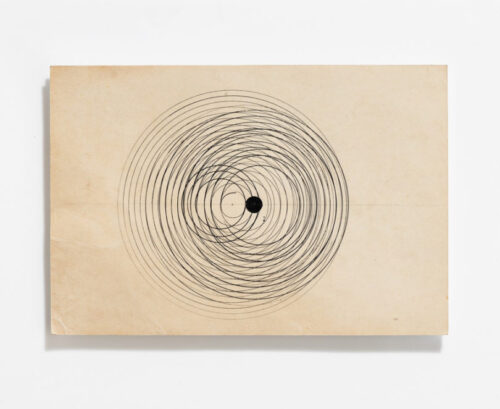
Waldemar Cordeiro
When those bronze statues look back at us, we are transported to a place where consciousness is uncertain. As a a short digression here, the homoerotic aspect of Greek art and culture is well established, but I worry a good deal about the new insistence on anti-Winklemann(ness) and his demand for whiteness (in marble) { also note Michaelangelos’s sculpture in the Medici Chapel in Florence, and the remarkable whiteness of the marble used for the female figure of Dawn for Duke Urbino’s tomb}. I am sure …well, not sure but for the sake of argument lets say I am sure much marble was coloured. My point is that it is not coloured in the way contemporary critics imagine. And the Bronze statuary is relevant to this, I believe. I feel often that contemporary critics imagine Greek statues as if done by Tom of Finland or on pedestals in Vegas casinos. And this is not the case. The surface lucidity and polished reflectivity of Greek statuary was not a camp romp, it was a metaphysical project that engendered the ‘returning gaze’. And this becomes the essence of this entire discussion. The Faculty of Classics has a Youtube video out, with a lecture by one of their profs (sigh)…and I am sorry, but the statues were not coloured in this way. Or, you are assuming simple bad taste on the part of the Greeks (or they were all Donald Trump). This carnival side show tawdriness is antithetical to the ancient Greek sensibility.
https://youtu.be/cYrN0IN07VM?si=OWIzZaZN7AIGcUSy
and worse is this
https://www.youtube.com/watch?v=kNidOhCKwSA
“Von Kleist’s 1805 essay, “On the Gradual Construction of Thoughts During Speech,” suggests that preformed thoughts and the ability to articulate such thoughts are not as mutually dependent as Enlightenment proponents might believe. He presciently proposes that speech might, in fact, stimulate thought, declaring: “It is not we who know, but at first it is only a certain state of mind of ours that knows.”
Jessica D. Brier (Seen, Known, Danced and Spoken: Heinrich von Kleist and the Limits of Being Human)
The quality of the metaphysical inherent in these Bronze statuary (as we guess as what they looked like before a thousand years underwater) is consistent with Greek thought. Certainly with Pre-Socratic thought. But also with later tragic drama. The mask becomes another mechanism of the impersonal. The giving up of identity. But there is a dialectic here; giving up only to get it back modified, or amplified. One sees why Hollywood slasher films almost all portray their psycho killers masked.
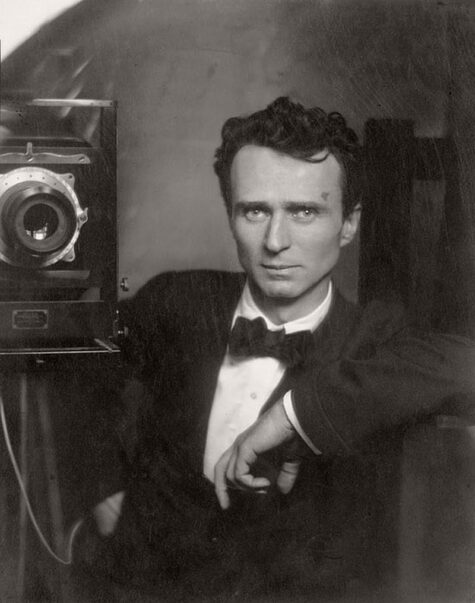
Edward Steichen, photography (self portrait, 1917)
This idea that these statues being colorized (much as black and white film was colorized) is in any way an improvement makes me feel as I am being gaslighted by Academia. And that would raise questions about motivation. But lets put a pin in that for a moment (as they say during corporate power point presentations) and return to Nietzsche and the Greeks. Now there is an interesting section in Babich’s book Words in Blood, Like Flowers Philosophy and Poetry, Music and Eros in Hölderlin, Nietzsche, and Heidegger, on the personal quality in Nietzsche’s writing.
“David B. Allison has highlighted this style in terms of the arresting quality of its deeply personal appeal: “Nietzsche writes exclusively for you. Not at you, but for you. For you, the reader. Only you.” And Nietzsche himself analyses the direct address of such a writing style:—to you, “only you,”—educing the model of the Bible as the paradigmatic book of books, a book for all the world, Allerweltsbücher.”
I remember reading Nietzsche for the first time when I was about sixteen. And I read him off and on for the next decade. And I always felt that sense of being spoken to from a voice in the past. It ‘was’ personal. But also, this reminds one (again) of Auerbach’s first chapter in Mimesis. For Auerbach it was exclusively the Old Testament, but the point remains, I think. Nietzsche’s prose style is in that line from the Bible to Milton to Kafka to Melville. And Adorno. (and probably Wittgenstein).

Maximilian Reinitz
“The problem of the actor has troubled me for a very long time; I was unsure (and still sometimes am) whether it is only from this angle that one can approach the dangerous concept of the ‘artist’ – a concept that has heretofore been treated with unpardonable generosity. Falseness with a good conscience; the delight in pretence erupting as a power that pushes aside, floods, and at times extinguishes one’s so-called ‘character’; the inner longing for a role and mask, for an appearance (Schein); an excess of capacities for all kinds of adaptation that can no longer be satisfied in the service of the nearest, most narrowly construed utility – perhaps all of this is distinctive not only of the actor? ”
Friedrich Nietzsche ( The Gay Science )
Babich has a pretty pithy take on this: “In a single, evocative aphorism, “The Problem of the Artist”, Nietzsche proposes a concisely phenomenological investigation of the artist. Bracketing, as “dangerous,” a direct focus on the artist, the actor is reviewed and then left off in favor of the Jew and, still yielding an epistemic tension with reference to the mask, subsequently given over to the intercalation of “diplomacy,” and the pragmatics of rhetoric. { } In the same way, the “problem of the actor” (qua artist, fool, Jew, diplomat, rhetorician, woman) articulates the hysterical sarcasm that represents Nietzsche’s ultimate word on the problem as a whole: “Woman is so artistic.”
Babette Babich (Ibid)
And there is a telling reference to Klaus Theweleit, too. And its unsurprising, I suppose, that Theweleit surfaces so often in discussions of contemporary psychology. This brings together a lot of threads regarding the philistinism so prevalent today (see Trump’s military parade this week). The advent of AI looms here, too, and technology in general, but particularly cyber tech. For the returned gaze, the investigation of interior lives, of ‘our’ life, is increasingly discouraged and screen technology serves as the anti-depth gaze. Art criticism, that of the pop variety mostly but indeed all of it to some extent, has privileged a position of interpretation that sees ‘surface’ as worthy of respect. Shallowness is actually applauded (and is aligned with camp, irony, and an eradication of sincerity). And I remember reading much criticism of even Abstract Expressionism, and then color field painting as being about ‘paint’ only, about surface. And this is stunningly not true. Like the highly polished Bronzes of Greece, the surface is not only surface. It is a dialectical relationship of the ‘gaze’. Now this begs questions about ‘lifelike’ which I think at a certain point sort of distracts from the unconscious processes of aesthetic experience.

Vincent Valdez
Gabor Mate called the genocide of Gaza like watching Auschwitz on Tiktok. Social media is ideology. There are certainly progressive aspects to it, and many work hard to overcome the toxic quality of the entire phenomenon, but its always an uphill struggle. But to stay with the actor, with masks, with an idea of the ‘returned gaze’, the example of Disneyland is worth examining. For the ascension of ‘leisure’ as an existential category has rendered much of the contemporary West as participants in a mass fascist cartoon.
“Disneyland is the representation realized in a geographical space of the imaginary relationship that the dominant groups of American society maintain with their real conditions of existence, with the real history of the United States, and with the space outside of its borders. Disneyland is a fantasmatic projection of the history of the American nation, of the way in which this history was conceived with regard to other peoples and to the natural world. Disneyland is an immense and displaced metaphor of the system of representations and values unique to American society.”
Louis Marin (Utopics: A Spatial Play)
The amusement park itself is a kind of ideological apparatus. Disney, himself a member of the American Nazi Party (while it lasted) employed Werner Von Braun as the face of Tomorrowland, a rehabilitated Nazi scientist, and provided a much publicized tour of the park for Nazi filmmaker Leni Riefenstahl. But never mind, the salient part here is the manner in which western Imperialist society has come to replicate Disneyland.
“Because this place is a stage and place of projection where we can view and test out the ideology of the dominant groups in American society, we might assume that this world built by Walt Disney fulfills the critical function for ideology we noted for utopic production in general. This is not the case, however, because this “stage’’ where ideology is put into play and where its critical function comes to operate is really not a stage. The visitors to Disneyland are on stage themselves; they are actors in the performance in which they act. They are captured, like a rat in a maze, and are alienated by their part without being aware of performing a part. { } the visitors to Disneyland are put in the place of the ceremonial storyteller. They recite the mythic narrative of the antagonistic origins of society. They go through the contradictions while they visit the complex; they are led from the pirates’ cave to an atomic submarine, from Sleeping Beauty’s castle to a rocketship. These sets reverse daily life’s determinism only to reaffirm it, but legitimated and justified. Their path through the park is the narrative, recounted umpteen times, of the deceptive harmonization of contrary elements, of the fictional solution to conflicting tensions. By “acting out” Disney’s utopia, the visitor “realizes” the ideology of America’s dominant groups as the mythic founding narrative for their own society.”
Louis Marin (Ibid)

Gottfried Helnwein
“History is thus unclear on whether in making Pinocchio, Disney was paying homage to the Nazis or simply pandering to them. (Fortunately, Hitler returned Disney’s affection: his favorite song was “Who’s Afraid of the Big Bad Wolf”; in 1937 Goebbels presented a birthday gift of 18 Mickey Mouse shorts to the Führer.”
Matt Roth (The Lion King, A Short History of Disney Fascism)
I don’t want to belabour low hanging fruit like Disneyland, but it is worth a reminder anyway. The implications of these machines for ‘fun’ and ‘amusement’ have come to occupy a significant place in the American psyche. And really, in all of the imperialist West. Disney was also rabidly anti-communist and a big supporter of Joe McCarthy. And lest we forget, McCarthy’s lawyer was Roy Cohn. And who mentored Donald Trump in his early days in New York? Roy Cohn. (Bobby Kennedy, too, was a staffer for McCarthy, and the red baiting Senator was a close friend of the Kennedy family even dating two of Bobby’s sisters. RFK Jr. then is not a surprise alley of Trump) But I digress. Disneyland valorizes the aristocrat, and nearly all of Disney films feature the struggles of royalty to achieve their proper place of privilege, the throne.
“I would posit to you that nothing Walt Disney did in his entire life was apolitical. Behind the cartoons was a hidden story of strike-breaking against the Animators. Deep in the subtext of every film was a message of inequality, racism, and sexism. When Disney wasn’t in the studios in the 1930s, he was off at American Nazi Party rallies.”
Dave Schneider (Uncle Walt’s Kingdom: The Fascist Political Economy of Disney World)
The Greek Bronzes then, are, as noted above, projects of metaphysical ambition. It is the dangerous quality of that returning gaze that so unsettles us because it is at this point in the formation of our psyche that we encounter that absence, that missed appointment (see three previous blog posts for more on this). But this is perhaps the core enigma of our sentient selves. Our *fall* into language. The latinizing of something Greek, something Dionysian and inexpressible. And it may be that language, speech, was that which mediated the death drive. Or it may be that writing became some dialectical recuperation of primordial speech.

Will Cotton
“From the beginning, Nietzsche regarded the modern scientific progress ideal as the optimistic fulfillment of Socrates’ invention of modern scientific thinking, that is, a rational inversion of tragic culture characterized by a profound hatred of change or becoming. The same antipathy to process and becoming undergirds the technological enthusiasm of contemporary Western culture. Our horror of the desultory effects endemic to the corruptions of becoming and time means that we want technological fixes in our cosmetics and (ideally) in our medicines for aging, sickness, death, and decay. To all appearances—and appearances are all that matter—we want the same fixes on the same values in our engineering science for environmental disorders and contamination. In this way, the cult of the new denies (mortal) change. This is the contemporary cult of juvenile perfection: all promise and potential, nothing actual or real—unsullied by quotidian exhaustions or the everyday detours and spiritual stultificaton of procreative investment or the wearing costs of both consummation and growth, not to speak of the desultory transformations of illness and senescence/decadence.”
Babette Babich (Ibid)
That the rise of science, of a certain scientism, really, and Capitalism as it evolved post WW2, which can now be seen as partly (at the least) as a way to protect Fascism, found the line of least resistance to be infantilization of the entire culture. The default setting for this instrumentalized rationality after Plato, projected after and later finding fulfilment in the Enlightenment, naturally, logically, looked for ‘progress’ as the ultimate virtue. The waning of Enlightenment values meant an increasing dependence on technology. And in quantum physics the road of fetishized rationality finds it dead end. Hadron Collider as cul de sac. A quick fix because attention spans don’t have the patience for long ones. Infantile also means primary narcissism. Remember the Ego strives to return to its state of primary narcissism. Technology reflects back nothing but surfaces. This lost gaze has meant a kind of subliminal panic that teeters on the precipice for ‘us’ all the time. The obsessive need for ‘progress’ fits seamlessly with capitalism, and with the specific direction Christianity took. (That the Vatican loved the Nazis and dictators like Franco, or worked closely with the Ustaše in Croatia, is hardly a surprise).
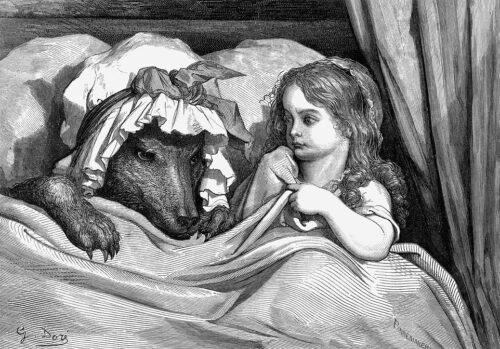
Gustove Dore, illustration for Little Red Riding Hood. (1862)
“Following in the wake of the inversion of Platonism by way of the Hellenic invention of Judeo-Christianity and the latter’s conversion into Western scientific rationality and techno-culture, we today are careful to reserve our enthusiasm not for a tragic affirmation of becoming (i.e., with a choral affirmation of coming undone), but, and instead, we keep our rounds for the latest banausic invention and preservation. Adverting to the ordinary images of consumer culture, we will buy anything that promises to keep us healthy or beautiful and if we might avoid illness, accidents, or age, any one of us could spare a curse for Nietzsche’s lonely, moonlight demon arrived to sell the eternal return of the same. The eternal ideal: eternal love, eternal life, eternal youth, yes; but the eternal return, life as it is/was, just as it is/was, no. We want, because we desperately need, a non-literal interpretation of Nietzsche’s teaching of the Eternal Return of the same.”
Babette Babich (Ibid)
That point where Christianity aligned with western scientific rationality (and progress) is a fateful one. And here its useful to segue a bit to Freud. In a paper from 1916, Freud, writing about criminality and criminals, noted one type of criminal…
“suffering from an oppressive feeling of guilt, of which he did not know the origin, and after he had committed a misdeed this oppression was mitigated. His sense of guilt was at least attached to something. Paradoxical as it may sound, I must maintain that the sense of guilt was present before the misdeed, that it did not arise from it, but conversely—the misdeed, arose from the sense of guilt?”
Sigmund Freud (Some Character-Types Met with in Psycho-Analytic Work)
This is also the paper in which he directly quotes Nietzsche.
“The pre-existence of the feeling of guilt, and the utilization of a deed in order to rationalize this feeling, glimmer before us in Zarathustra’s sayings ‘On the Pale Criminal’.”

Aryo Toh Djojo
Here then we circle back to the Oedipus Complex once again.
“Henry Staten writes of Nietzsche demonstrating that the relation between self and other has to be rethought as a dialectic in which the self finds its reflection in the other and the other is then reflected back into the self. This is the same dialectic rediscovered by Freud in the metapsychology of 1915 and later. Pain that is experienced as pleasure; the pervasiveness of narcissism; and aggressivity in the dialectic of identifications by which the self is constituted: Freud’s articulation of these themes is strikingly parallel to Nietzsche’s, but it is more explicit and systematic.”
Ronald Lehrer (Nietzsche’s Presence in Freud’s Life and Thought) (Harry Staten: Nietzsche’s Voice)
The reflection of the other. Lacan of course said the unconscious was the discourse of the ‘other’. Those bronze statues return or reflect back to us our own gaze. In a culture without that return (Walt Disney and The Spectacle) the Oedipus complex is unresolvable.
“…we can add that there is in fact a well-known and most crucial parricide in Nietzsche as well as in Freud. Zarathustra is famous for its announcement of the death of God, this death being presented as of central significance for humankind. God is presented at one point as dying of pity at mankind’s state and at another point is presented as having been murdered by “The Ugliest Man.”! But there is also one of Nietzsche’s most wellknown passages from another book, the parable of the madman in The Gay Science: “‘Whither is God?’” he cried; ‘I will tell you. We have killed him—you and I. All of us are his murderers.’? We have murdered the Father. For Nietzsche this symbolic parracide marks a critical juncture in the course of civilization, and its full consequences and implications must be, with great difficulty, fully and integrated in the service of creative growth and affirmation of life. For Freud the primal parracide, an actual parracide, is placed at the other critical juncture, the origin of civilization and, ultimately, the birth of God, although it is endlessly repeated.”
Ronald Lehrer (Ibid)
And it occurs to me that a Nietzschian reading of Zionism is probably in order here.
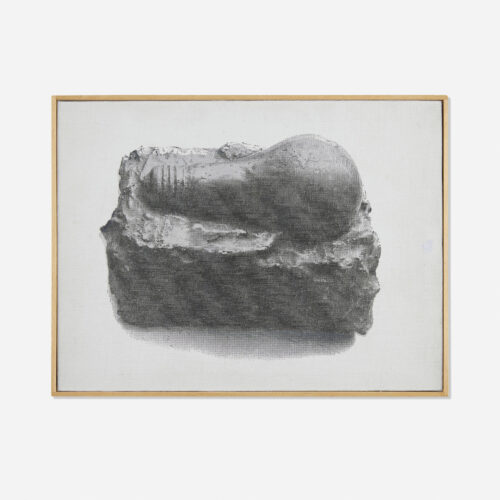
Richard Pettibone (acrylic and photo-engraving, 1965. Lightbulb; Jasper Johns)
“For Nietzsche as well as for other contemporary philosophers otherwise unrelated to him, like Levinas and Theunissen but also like Theodor Adorno, who knew how to read Nietzsche critically but who also went far beyond him on just this question, philosophy can hardly do better than to begin (and to end) with the problem of suffering exactly as this is related to joy. { } For it is absolutely crucial to recognize that Nietzsche’s diagnostic reading of the will to power neither celebrates nor does it prescribe
power over other people.”
Babette Babich (Ibid)
Global madness is reaching a degree of ‘impossible’ now. Fascism never was defeated. Perhaps it cannot be defeated per se. And this is why several of my recent posts have discussed resentment. And have tried ploddingly to disentangle the infinitely complex mechanisms at work both collectively and individually.
” What is important to understand in this claim that the weak can (and do) have dominion (or does one really believe that the power elites of this world correspond to what Nietzsche meant by the “noble” or the “strong”?) concerns the extraordinary, world building, and culture-creating force of ressentiment. And yet, and this is Nietzsche’s subtlest insight, because ressentiment, because what he calls slave morality is reactive it never attains to nobility, it never becomes active even at the moment of success or supremacy. Because it remains a morality of implacable resentment, it continues to resent even in a position of dominion, going so far, when it finds itself without an external obstacle, as to turn upon itself. Thus we do well to consider, as Nietzsche sought to remind us, that the victim of any kind of violence, not only physical but also psychological and emotional, that is, in whatever register at all, to use Lacan’s canonic terminology: imaginary, symbolic, Real, is also seething with the kind of anger that is not only inverted but is of such a valence that it will never, because it can never, burn itself out.”
Babette Babich (Ibid)
And a bit later there is a concluding sentence…“Nietzsche turns his appeal to the artists rather than to the theologians.”
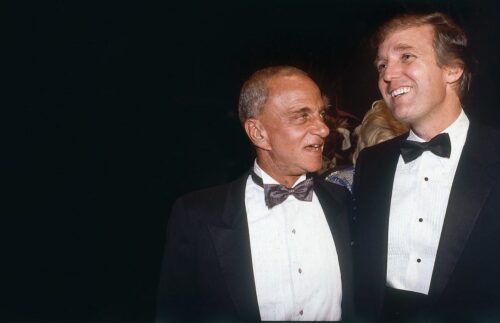
Roy Cohn and Donald Trump, Studio 54, date unknown.
“As psychologist, using the biological metaphor of pulsion, Nietzsche always traces the genealogy of need. But Nietzsche never traces a genealogy just to leave it there and here he uncovers the frisson at the heart of every basic need. In the same fashion and in the same locus he captures the desperation of a god. In a reading that is anything but anti-Christian, Nietzsche reads the stories told of the life of Jesus as “one of the most painful cases of the martyrdom, of knowledge about love” (BGE §269, cf. 270). To negotiate the inadequacy of human love and the deiform infinity of desire (Cartesian, Augustinian “will”), Nietzsche dares a painful series of reflections concerning what a God of love would have had to come to know, to learn about love . { } As the non-erotic god of love, the anti-Dionysus par excellence (Nietzsche does not have Hölderlin’s syncretistic temperament), the sky God of the Jews fell from nomadic jealousy and a thunder-god’s vengeance to become the cloying god, the god of nuzzling, Judeo-Christian neediness.”
Babette Babich (Ibid)
I said in a recent post that Nietzsche’s assaults on Christianity yielded the greatest Christian philosopher of all time. In the same way Wittgenstein was a top psychoanalyst of the century despite never writing anything psychoanalytic (except for a few terse and hostile lines about Freud). Lack. Richard 2nd is never more kingly than when removing his crown in abdication. The actor is never more himself than when he totally removes the self. (it is interesting that the actor, with lines memorized, often finds himself — as lights come up — like a deer stuck in the headlights. Stricken with panic and terror. He cannot remember a single word of the play, of his part. The actor who has lost himself IN his part, is doing so metaphorically. The actor struck with existential panic, is losing himself in another register.
The needy clingy God of American televangelism (they cry a lot, in public televised rituals) is still the Baptist God of managerial expertise, as well (and I do not joke when I mention the extreme shininess of the hair, especially men’s, much like NCAA football coaches, often). The Pimp God of various Hindu prophets (latter day). The cult of self improvement is also the cult of ‘learn to make money’, often called ‘learning to make your life work’. But the clingy needy God is almost the by-product of the self self sabotaging Christian Church of the Inquisition (although I’m not sure the post Reformation Church was not just as self sabotaging). For this is the deep dialectic of Nietzsche, and this can be the uncanny and unsettling aspect to reading Nietzsche. And here Kafka needs to be mentioned, for not just Before the Law, but The Trial and more significantly perhaps, The Castle. (and Camus, I think it should be noted, and certainly Melville). Our guilt for something, an absence. Guilt for our instincts or drives. And God then, must be emptied of carnality. To allow ourselves to act on instincts we believe are criminal or immoral requires a belief in that pure God of asexuality.
“The ancestors of the most powerful tribes are bound eventually to grow to monstrous dimensions through the imagination of growing fear and to recede into the darkness of the divinely uncanny and unimaginable: in the end the ancestor must necessarily be transfigured into a god. Perhaps this is even the origin of gods.”
Friedrich Nietzsche (On the Genealogy of Morals)
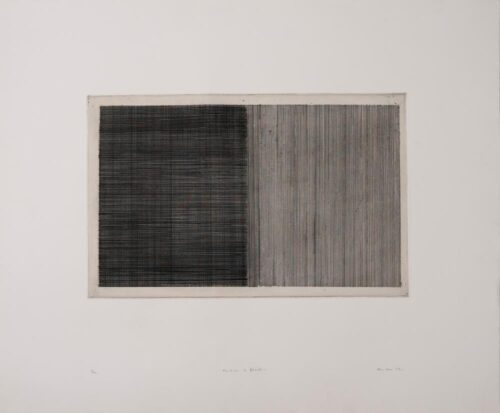
Alan Green
As a side bar of sorts, Susan Sontag’s now famous essay on Nazi style (both amazingly insightful and also stunningly wrong on certain things) is worth noting again.
“Fascist aesthetics include but go far beyond the rather special celebration of the primitive to be found in The Nuba. They also flow from (and justify) a preoccupation with situations of control, submissive behavior, and extravagant effort; they exalt two seemingly opposite states, egomania and servitude. The relations of domination and enslavement take the form of a characteristic pageantry: the massing of groups of people; the turning of people into things; the multiplication of things and grouping of people/things around an all-powerful, hypnotic leader figure or force. The fascist dramaturgy centers on the orgiastic transactions between mighty forces and their puppets. Its choreography alternates between ceaseless motion and a congealed, static, “virile” posing. Fascist art glorifies surrender; it exalts mindlessness: it glamorizes death.Such art is hardly confined to works labeled as fascist or produced under fascist governments. (To keep to films only, Walt Disney’s Fantasia, Busby Berkeley’s The Gang’s All Here, and Kubrick’s 2001 can also be seen as illustrating certain of the formal structures, and the themes, of fascist art.)”
Susan Sontag (Fascinating Fascism, NYRB 1975)
One can include Robert Wilson here, too. But Sontag also sees Riefenstahl’s photography book The Nuba as ‘stunning’. And actually its barely kitsch, albeit with a throughly racist fetishizing of blackness (though mostly covered in mud), but one that is really more about death, and in that sense perhaps it ‘is’ a great monument to fascist aesthetics. But I digress. The contemporary class of cartoon leadership is clearly not really leading. Remember George Bush Junior telling the press (confessing to the press) ‘God told me to end the tyranny in Iraq’.
The need for punishment, the desire, if you want, for punishment is something both Freud and Nietzsche wrote about. (by the way I doubt Freud was being honest when he said he never read Nietzsche, not that it matters, but the overlap has always been obvious). It is the externalization of unconscious feelings. Of unconscious guilt.
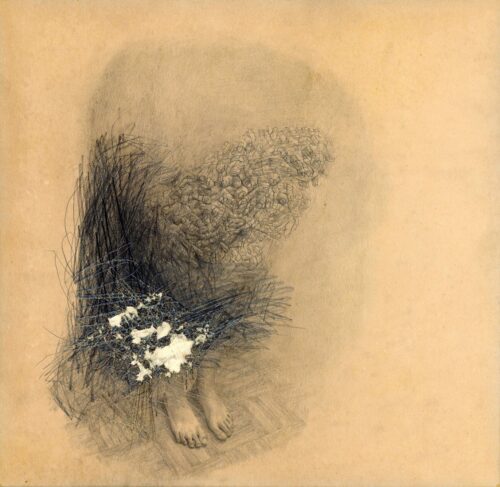
Monika Cichoń
“It was a surprise to find that an increase in this Ucs. sense of guilt can turn people into criminals. But it is undoubtedly a fact. In many criminals, especially youthful ones, it is possible to detect a very powerful sense of guilt which existed before the crime, and is therefore not its result but its motive. It is as if it was a relief to be abIe to fasten this unconscious sense of guilt on to something real and immediate.”
Sigmund Freud (The Ego and the Id) 1923.
This is Nietzsche’s The Pale Criminal. Those who feel no guilt but commit crimes are Rosy Criminals (to put it in Readers Digest version).
“These two taboos (killing the totem and marrying inside one’s clan) correspond to the two aspects of the Oedipus complex, namely, the killing of the father and the taking of the mother as a wife and are the basis of morality, religion and social organisation.”
Stephen J. Costello (The Pale Criminal)
“In the beginning was the deed.”
Goethe (Faust)
I want to here wrap up this first part of this post. Part two coming soon. But a few final thoughts. The masochist’s performance (more on that aspect next time) “accords with these phantasies of being gagged, bound, beaten, whipped, derided and debased. The masochist wishes to be treated like a naughty child. Such phantasies place the subject in the female situation and signify being castrated or copulated with. In the case of moral masochism it is suffering itself that matters, but not necessarily inflicted by the loved object or endured at his command. ‘The true masochist always turns his cheek whenever he has a chance of receiving a blow’ (Freud)”.
Stephen J. Costello (Ibid)
Think back to the submissive reader of early Greece. The bottom. The penchant for uniforms in Fascist iconography. The infantilisation of contemporary culture. And of the ascension of so many political leaders in the US committed to the clingy God of Evangelical Christianity (Ted Cruz, Mike Pompeo, Mike Huckabee, Mike Pence, Pete Hegseth et al).
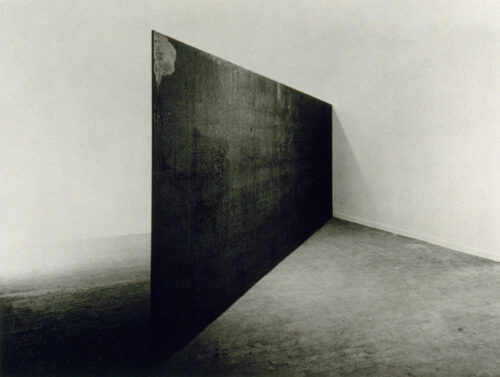
Richard Serra
“Moral masochists are dominated by morally inhibited and sensitive consciences, whose needs are satisfied by suffering and punishment at the hands of a parental power. According to Freud, masochism or the turning of sadism against the subject, is due to cultural suppression of the instincts and “the suppression of an instinct can … result in a sense of guilt and … a person’s conscience becomes more severe and more sensitive the more he refrains from aggression against others.”
Stephen J. Costello (Ibid)
There is a tension between Ego and Super-Ego revolving around the consciousness of guilt. Of the Ego not living up to the ideal demanded by the Super-Ego.
“Sadism (the death drive) is entwined with the erotic aim. The struggle between Eros and Thanatos, between life and death, love and hate, works itself out in the human species. ‘This struggle is what all liIe essentially consists of, and the evolution of civilization may therefore be simply described as the struggle for life of the human species. And it is this battle of the giants that our nurse-maids try to appease with their lullaby about Heaven’ (Freud).”
Stephen J. Costello (Ibid)
Love is a protection against the punishing aggression of an external authority.
“There are thus two origins of the sense of guilt: one that arises from fear of authority and the second one, which later on arises from fear of the superego. Where the first will insist on a renunciation of instinctual satisfactions, the second one will press for punishment.”
Stephen J. Costello (Ibid)
To donate to this blog, and to the Aesthetic Resistance podcasts
https://aestheticresistance.substack.com/
use the paypal button at the top of the page.

I’d also been thinking recently of theater, and my past as a performer, and needing an audience. I used to say that people who had never seen me onstage couldn’t possibly know me. I think that feeling is pretty universal in performers, Nijinsky even wrote that in his diary—If you haven’t seen me dance, you can’t possibly understand me.
And yet, what does that mean? Is it just, as in Fosse’s Chicago, where Roxie says “we perform because we didn’t get enough love at home?” probably simplified, but, sure. But there’s something else too. Being onstage is not seeing oneself in a mirror, but it is, a little bit, being able to control the opening, to control the vulnerability of seeing oneself.
On the other hand, it, for me, very much had to do with some kind of (dare i say it), ritual of acceptance or, that’s not the right word, but something other than purely the thrill of performing. Although there was always that. But there was always something of “contest” as Babich puts it, about it. And also, a convoluted way to “know oneself” through the words and steps of someone else.
More questions than answers for sure!
I think that back in hunter gatherer days, everyone at one point or another got up in front of the group and did something like performing. In some families (not western ones really, anymore) people used to do that, sing together or something. Now we who perform are specialists, and somehow (apparently) lack something else. And are seen sometimes as not being able to function in the “real” world). Hence, the current careerism and MFAs and insistence on theater as either institutionalized and credentialized or as “therapy” somehow. The inferiority complex of being a performer in a capitalist world has come full circle to banality because nothing else sells.
Just musing here. Kind of off topic too, but I also have been thinking a lot about theater lately, and, of course, my particular role in it and need for it. And what that means.
Thanks again for your blog and podcasts with Hiroyuki, Dennis and everyone else!
And of course, sorry, I’m just blathering on: but Lorca’s idea of Duende which comes when there is a presence of death in the room, seems to me extremely pertinent to performing. One can always “die” onstage in one way or another.
And that is precisely what is lacking in what I see (when I do go to shows) today. Death is not allowed. I even saw a Flamenco festival that was very “spectacular” with brilliant dancers. And nothing, no admittance of death, or even the possibility of losing ground.
thanks for these thoughts. Id agree completely with your hunter/gatherer description. I think that ‘performance’…the creation of a ‘stage’ came well before religion. The religious was maybe the very front edges of institutionalizing this process of psychic formation, or it was what preceded the institutionalizing of it. This coincided with this idea of language and writing as a turn away from this core or foundational idea of a stage and us or them on it. I think for sure there is a connection with rehearsal (which nobody talks about) and repetition and compulsion etc. But there is a dialectic…the obsessive repetition becomes something else, a way to unblock the compulsiveness. But theatre today is like the artistic equivalent of televangelism. And no death….great point. Ive written on Lorca and Duende before. I heard bly speak about it once. This is very important. There is some sort of psychic aperture for the unconscious….some of this will be in part two. Anyway, imm so glad you both like the writing and take the time to comment.
Yes–rehearsal–I loved that process. Just one more thought–it used to be that people would fall in love with each other during a rehearsal for a show, I mean sometimes really temporary but there was a charge to it. Now, I don’t see that at all. In the few shows I’ve taken part in recently there’s an anodyne sort of camaraderie that’s really different than, say, even 10 years ago. Or maybe 20. I blamed it on wokeness, but there’s something else going on too.
Ok basta ya. Looking forward to part 2!
i think i must have written something about this, a long ways back…before this blog. The intimacy of performance. And more, of rehearsal. There IS something more and I am going to ponder that.